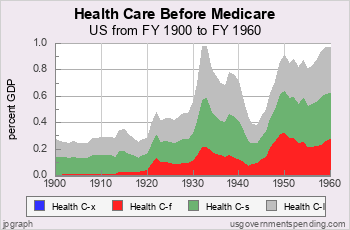Numbers — Charts:
History:
Analyses:
| Tweet | | Contact | Follow @chrischantrill |
a usgovernmentspending.com briefing:
US Health Care Spending History from 1900
In 1902 governments in the United States spent 0.25 percent of GDP on health care programs. In 1960 health care spending
had almost reached one percent of GDP. In the late 2010s governments spend about 8 percent of GDP on health care programs.
Suggested Video: US Defense Spending
Top Spending Requests:
Find DEFICIT stats and history.
Get WELFARE stats and history.
US BUDGET overview and pie chart.
Find NATIONAL DEBT today.
DOWNLOAD spending data or debt data.
See FEDERAL BUDGET breakdown and estimated vs. actual.
MILITARY SPENDING details, budget and history.
ENTITLEMENT SPENDING history.
See BAR CHARTS of spending, debt.
Check STATE spending: CA NY TX FL and compare.
See SPENDING ANALYSIS briefing.
See SPENDING HISTORY briefing.
Take a COURSE at Spending 101.
Make your own CUSTOM CHART.
Spending Data Sources
Spending data is from official government sources.
- Federal spending data since 1962 comes from the president’s budget.
- All other spending data comes from the US Census Bureau.
Gross Domestic Product data comes from US Bureau of Economic Analysis and measuringworth.com.
Detailed table of spending data sources here.
Medicare breakdown here; Medicaid breakdown here.
Federal spending data begins in 1792.
State and local spending data begins in 1820.
State and local spending data for individual states begins in 1957.
Gross Federal Debt
| Debt Now: | $37,889,756,572,760.44 | Debt 2/2020: | $23,409,959,150,243.63 |
Site Search
Spending 101
Take a course in government spending:
Spending |
Federal Debt |
Revenue
Defense |
Welfare |
Healthcare |
Education
Debt History |
Entitlements |
Deficits
State Spending |
State Taxes |
State Debt
It’s free!
Win Cash for Bugs
File a valid bug report and get a $5 Amazon Gift Certificate.
Get the Books
 Price: $0.99 Or download for free. |
 From usgovernment spending.com Price: $1.99 |
 Life after liberalism Price: $0.99 Or download for free. |
Blog
State and Local Finances for 2023
On September 11, 2025 we updated the state and local spending and revenue for FY 2023 using the new Census Bureau State and Local Government Finances summaries for FY 2023 released on July 31, 2025. (See also Annual Survey of State and Local Government Finances). The release includes state and local spending for the United States as a whole and the 50 individual states and the District of Columbia.
State and local spending and revenue for FY2023 are now actual historical spending as reported by the Census Bureau. In addition, the Census Bureau published updated tables for 2021 and 2022.
We have updated the "guesstimated" state and local finances for FY2024-30 as indicated in our "guesstimate" blog entries.
We have also updated data for individual local government units with data for 2023.
Beginning in 2022 the Census Bureau has changed the value for Line 56 Direct Expenditure and Line 7 General Revenue from own sources, as follows:
We have decided to end our publication of non-insurance trust cash and security holdings.
However, to keep the time series at usgovernmentspending.com consistent, we have decided to add insurance-trust values back into Line 56 and Line 7 values.
In March 2025 the US Census Bureau released data on state finances for FY 2023 here and ...
On June 24, 2025, usgovernmentspending.com updated its data for agency debt from the Federal Reserve Board database. Data is now available for the period 1945-2024. You can see our Agency Debt page ...
> blog
Budget News
President’s FY 2025 Budget Release Scheduled for March 11
Although the FY 2024 appropriations process is not yet resolved
Biden to Release Budget March 9
will press McCarthy On Default Risk - Bloomberg
Biden to Release 2023 Budget Request on March 28
how the administration expects to spend money for priorities including aid to Ukraine and the continuing effort to fight the coronavirus pandemic, as well as legislative proposals such as increased funding for community policing programs, cancer research, and mental health education.
> archive
Spend Links
us numbers • us budget • custom chart • deficit/gdp • spend/gdp • debt/gdp • us gdp • us real gdp • state gdp • breakdown • federal • state • local • 2024 • 2025 • 2026 • california • texas




 - Local direct spending
- Local direct spending - State direct spending
- State direct spending - Federal direct spending
- Federal direct spending - Transfer to state and local
- Transfer to state and local

